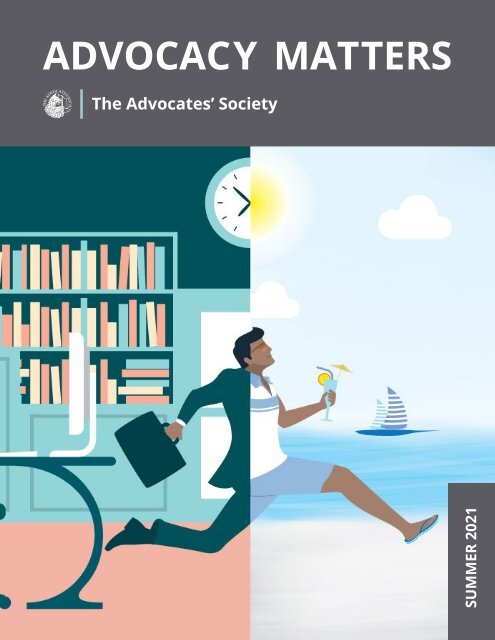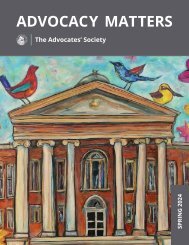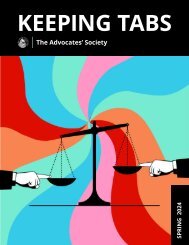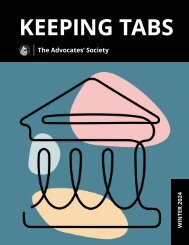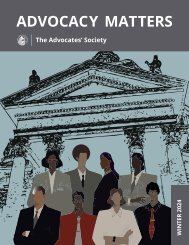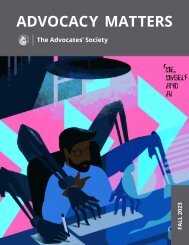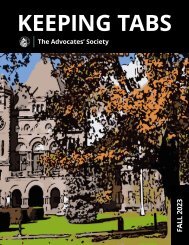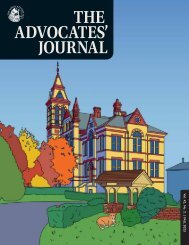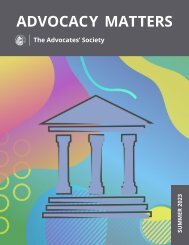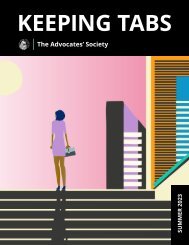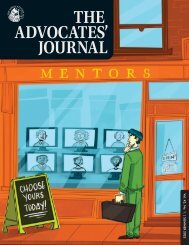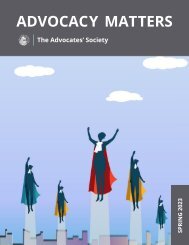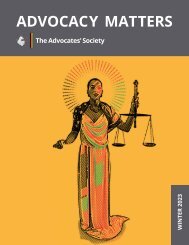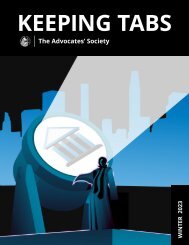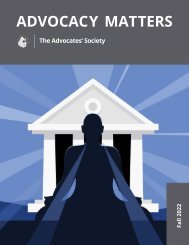Advocacy-Matters-Summer-2021
Keep up to date on what your fellow Society members have to say in Advocacy Matters.
Keep up to date on what your fellow Society members have to say in Advocacy Matters.
Create successful ePaper yourself
Turn your PDF publications into a flip-book with our unique Google optimized e-Paper software.
ADVOCACY MATTERS<br />
The Advocates’ Society<br />
SUMMER <strong>2021</strong>
#TASProud<br />
Congratulations to the TAS leaders appointed to the bench<br />
in 2020/21 to serve the justice system after going above and<br />
beyond to serve our members and the work of TAS.<br />
The Hon. Justice Kathleen Erin Cullin, former TAS Board Member<br />
appointed a Judge of the Superior Court of Justice of Ontario.<br />
The Hon. Justice Kristin Muszynski, former YASC Kingston<br />
member appointed as a Judge of the Superior Court of Justice<br />
of Ontario.<br />
The Hon. Justice Alexander Pless, former TAS Board Member<br />
and Quebec Regional Advisory member appointed as a puisne<br />
judge of the Superior Court of Quebec.<br />
The Hon. Justice Roger Chown, former TAS Board Member<br />
appointed as a Judge of the Superior Court of Justice of Ontario.<br />
The Hon. Justice Simon Coval, former Chair of British Columbia<br />
Regional Advisory Committee appointed as a Judge of the Supreme<br />
Court of British Columbia.<br />
The Hon. Justice Marie-Andrée Vermette, former TAS Board<br />
Member appointed as a Judge of the Superior Court of Justice<br />
of Ontario.<br />
The Hon. Justice Lorena K. Harris, former Alberta Regional<br />
Advisory Committee member appointed as a Justice of the Court<br />
of Queen’s Bench of Alberta.<br />
The Hon. Justice Jill R. Presser, former TAS intervention counsel<br />
appointed as a Judge of the Superior Court of Justice of Ontario.<br />
The Hon. Justice Colin C.J. Feasby, former Appellate <strong>Advocacy</strong><br />
Practice Group Secretary appointed as a Justice of the Court of<br />
Queen’s Bench of Alberta.<br />
05<br />
08<br />
10<br />
19<br />
24<br />
What the TWEET is this?<br />
When you see this icon, throughout the publication,<br />
click on it to see what members are tweeting about.<br />
CONTENTS<br />
Chair Chat<br />
Emily Lawrence, Paliare Roland Rosenberg Rothstein LLP<br />
Mentoring Across Differences<br />
Lisa Marie Buccella, Aviva Trial Lawyers<br />
“You Don’t Look Like a Lawyer!”<br />
Megan Keenberg, C.S., Van Kralingen & Keenberg LLP<br />
Participating in the<br />
Modern <strong>Advocacy</strong> Task Force<br />
Featuring Steven Frankel, Davies Ward Phillips & Vineberg LLP, Frédéric<br />
Plamondon, Osler, Hoskin & Harcourt LLP, and Chloe Snider, Dentons<br />
Compiled by Tamara Ramsey, Dale & Lessmann LLP<br />
Interview with incoming TAS President,<br />
Deborah E. Palter<br />
Compiled by Michelle Alton, Tribunal General Counsel<br />
Editor: Tamara Ramsey, Dale & Lessmann LLP<br />
The opinions expressed by individual authors are their own and do not necessarily reflect the policies of The Advocates’ Society.<br />
<strong>Advocacy</strong> <strong>Matters</strong> Editorial Team: Andrew Gibbs, Department of Justice, Christine J. Vanderschoot, Vanderschoot Family Law, Megan Keenberg,<br />
Van Kralingen & Keenberg LLP, Daniel Baum, Langlois Avocats, S.E.N.C.R.L., Ayesha Laldin, Department of Justice, Michelle Alton, Workplace Safety<br />
and Insurance Appeals Tribunal<br />
3
CHAIR CHAT<br />
Chair Chat<br />
Emily Lawrence,<br />
Paliare Roland Rosenberg Rothstein LLP<br />
Now Live! Friends Who Argue - A new TAS podcast jointly<br />
hosted by our Young Advocate and 10+ Standing Committees.<br />
Segments will feature dialogue with the people who get what you<br />
do, as we delve into both the serious and lighthearted aspects of<br />
life as an advocate in Canada. Know a TAS member we should<br />
talk to? Contact Webnesh Haile at WHaile@singleton.com<br />
Thank you to our Technical Sponsor Dentons Canada LLP<br />
for their support in producing this podcast!<br />
<strong>Summer</strong> is upon us. As I take on the reins of the 10+ Committee for the <strong>2021</strong>-2022 term, I am<br />
struck with how much has changed in such a short period of time. As vaccination rates increase<br />
and re-opening talk begins in my city, I have been thinking about when and how our legal community<br />
will re-emerge from the last eighteen months.<br />
This coming year will be one slowly treading back into a new “new normal.” Big and small firms<br />
wrestle through if and/or when to bring lawyers and staff back into the office. I cannot wait until<br />
we are able to meet again in offices, courtrooms, robing rooms and restaurants but I approach the<br />
coming months with optimism and some trepidation.<br />
What are we coming back to? Reconnecting with friends, colleagues, clients and trusted staff,<br />
and returning to the best traditions of oral advocacy, yes. But also new colleagues we have never<br />
met in person; new calls who have never donned their robes and fought the poor acoustics<br />
of a large courtroom. Friends who have lost loved ones in Canada and abroad. Parents who are<br />
broken from home-schooling. Clients who love the benefits of remote representation, and clients<br />
who have been denied justice by backlog and delay. A society that is finally, maybe, reckoning with<br />
Canada’s historical and continuing anti-Black racism, anti-Muslim acts of terror, and the colonial<br />
oppression of Indigenous peoples. A possible fourth wave in the fall.<br />
This year, our Committee will continue our representation of mid-career advocates, the emerging<br />
and future leaders of the profession. We will concentrate our focus on evergreen themes –<br />
networking events, educational programming, speakers’ series on current topics – but all suffused<br />
with an acknowledgement that, individually and collectively, we have been changed by the last<br />
year and a half, in profound and tiny ways. This is a time to gather, share our experiences, fill our<br />
5
cups, and fill in some gaps.<br />
In the coming term, we will continue to focus<br />
on topics relevant to mid-career lawyers, as advocates,<br />
as business owners, as mentors and champions,<br />
and as holders of privilege and power in<br />
our communities. In an age of decreasing court<br />
time, so vividly detailed in TAS’ Modern <strong>Advocacy</strong><br />
Task Force report, our programming will focus on<br />
how to develop positive mentoring and championing<br />
relationships with our more junior colleagues<br />
(remotely and in-person). As the courts<br />
and the legal community negotiate the practice<br />
of advocacy post-pandemic, our Committee will<br />
continue to engage our demographic in topics<br />
relating to the business and management of our<br />
practices as businesses. As mentors, managers<br />
and business owners, we need to advance discussions<br />
about diversity, inclusion and equity within<br />
the legal system, and within our communities as<br />
a whole. We will explore how mid-career lawyers<br />
can be agents of renewal and change. As peers<br />
and friends, we need to acknowledge that this<br />
year has been a period of loss and grief, isolation,<br />
exhaustion, and insecurity for so many, and build<br />
spaces to discuss practices of well-being and resiliency<br />
within advocacy.<br />
I am excited and grateful to be chairing the 10+<br />
Committee now, in this year of transition. I will<br />
take many lessons from the extraordinary Yola<br />
Ventresca, the 2020-<strong>2021</strong> chair of this Committee,<br />
and much guidance from my co-executive members,<br />
Chloe Snider and Steven Frankel. Our 10+<br />
Committee members hail from across the country,<br />
and we are extremely fortunate to have members<br />
with diverse practice areas and experiences.<br />
Among them is the incredible team at <strong>Advocacy</strong><br />
<strong>Matters</strong> led by Tamara Ramsey. Inside you will find<br />
insightful pieces and interesting interviews.<br />
I look forward to the coming term. Watch your<br />
inboxes for news about our slate of thought-provoking<br />
and meaningful events. In the meantime,<br />
have a safe and restorative summer.<br />
Appellate <strong>Advocacy</strong><br />
Thursday, October 14, <strong>2021</strong><br />
1:00 pm - 4:30 pm (ET)<br />
Live Online<br />
Appellate <strong>Advocacy</strong> will provide you with key insights on how to<br />
capture and maintain the court’s attention and give your client the<br />
best chance for success. Appellate judges and experienced appeal<br />
counsel will share invaluable guidance on how you can improve<br />
your facta drafting, hearing preparation, oral argument and more.<br />
To learn more or register, click here<br />
or visit www.advocates.ca<br />
Smart Advocates<br />
Never Stop Learning<br />
The Bench Speaks<br />
Friday, November 26, <strong>2021</strong><br />
1:00 pm - 4:00 pm (ET)<br />
Live Online<br />
This year we will be bringing you judges from across the country<br />
to share their experiences in an interactive remote forum. We’ll<br />
hear from newly appointed judges and seasoned members of the<br />
Bench about their views on everything from the challenges of daily<br />
life in the pandemic across the country, access to justice, and how<br />
we can take what we’ve learned and improve our judicial system.<br />
To learn more or register, click here<br />
or visit www.advocates.ca<br />
6 7
the journey that mentees are on and noted that<br />
what may appear to be shared experiences can<br />
vary considerably below the surface and do not<br />
guarantee compatibility between a mentor and<br />
a mentee.<br />
EVENT REPORT<br />
Mentoring Across Differences<br />
Lisa Marie Buccella, Aviva Trial Lawyers<br />
In mentoring relationships, the ability to relate is often considered a key ingredient for success.<br />
That focus on relatability, however, comes with its own hazards: if we conflate our ability to relate<br />
with having shared characteristics—whether age, gender, cultural background or otherwise—we<br />
risk developing and learning from people only like ourselves, and in so doing, leaving others out.<br />
Tenured lawyers need to take the lead when it comes to mentoring across differences, creating<br />
the conditions for people from diverse backgrounds to feel included and thrive. On May 3, <strong>2021</strong>,<br />
the Mentoring Committee of The Advocates’ Society’s 10+ Standing Committee presented Mentoring<br />
Across Differences featuring panelists Megan Keenberg of Van Kralingen & Keenberg LLP, Lucas<br />
Lung of Lerners LLP, Jennifer Mathers McHenry<br />
of Mathers McHenry & Co., and Walied Soliman<br />
of Norton Rose Fulbright Canada LLP, and moderated<br />
by Sapna Thakker of Lax O’Sullivan Lisus<br />
Gottlieb. This piece shares some of the key insights<br />
from the event.<br />
Matching is beneficial... but<br />
Matching refers to instances where mentors<br />
and mentees are connected based on shared<br />
characteristics or backgrounds. This can be<br />
beneficial, as junior lawyers see a part of themselves<br />
in their mentor, and where both can connect<br />
through shared experiences. Walied Soliman<br />
spoke of an instance where he was able to<br />
meaningfully counsel a young lawyer on breaking<br />
fast during Ramadan or leaving a meeting<br />
for Friday prayers. Jennifer Mathers McHenry<br />
agreed matching can be important but noted<br />
it is not always available. She emphasized the<br />
importance of mentors seeking to understand<br />
Understand the career journey<br />
Linear career journeys are less common than a<br />
generation ago. In many cases, the career ladder<br />
has been replaced by the jungle gym, and<br />
people enter our profession at different points<br />
in their careers, and with different objectives.<br />
Understanding a mentee’s objectives in the profession<br />
and what they bring to the table is key;<br />
mentors need to be intentional in asking about<br />
career objectives and understanding how mentees<br />
can leverage diverse professional and personal<br />
backgrounds for the benefit of their clients,<br />
organizations, and the profession.<br />
Champion positive behaviors<br />
Jennifer Mathers McHenry noted that there<br />
continues to be a tendency in our industry to<br />
accept behaviors that wouldn’t be accepted outside<br />
of the industry. Shifting attitudes around<br />
work, accelerated by the COVID-19 pandemic<br />
and the #MeToo movement, have changed<br />
what is acceptable—not only tolerance for traditional<br />
“bad behavior” such as sexism, bullying<br />
and harassment but more broadly, behaviors<br />
and practices that compromise worth and wellbeing,<br />
such as inappropriate work-life boundaries.<br />
Lucas Lung noted that it can be challenging<br />
for young lawyers to address uncomfortable<br />
and unacceptable behaviors, while those more<br />
seasoned in the profession have become accustomed<br />
to turning the other way, offering their<br />
mentees sympathy and counselling avoidance<br />
instead of leveraging their credibility to effect<br />
positive change. Especially when mentoring<br />
across differences, understand that it requires<br />
courage for a mentee to discuss concerns of this<br />
nature, and it creates an obligation for mentors<br />
not just to support, but to act.<br />
8 9
THE LEGAL EXPERIENCE<br />
“You Don’t Look<br />
Like a Lawyer!”<br />
Megan Keenberg, C.S.,<br />
Van Kralingen & Keenberg LLP<br />
It was my first ex parte appearance. I spent hours trying to strike the right balance of zealous advocacy<br />
while giving full and frank disclosure. Robed and ready, I introduced myself to the court, “Megan<br />
Keenberg, K-E-E-N-B-E-R-G, first initial M.” The judge addressed me as “Megan” even though<br />
everyone else in court was addressed as “Counsel” or by their surnames. It was jarringly casual<br />
and threw me off a bit, but I regrouped and answered all his tough questions.<br />
My preparation paid off. Order in hand, I ran back to the office triumphant. “I got the Order!”<br />
My principal clasped his hands together, cocked his head to the side and said, “Awww. The judge<br />
thinks you’re pretty!” In an instant, my jubilation<br />
evaporated. All that hard work undermined; the<br />
win discounted. My face fell. “C’mon,” he said<br />
with a light side hug, “I’m joking! Lighten up.” I<br />
bristled, knowing that it would never occur to<br />
him to joke that a male colleague got a favourable<br />
order because he’s handsome. But I didn’t<br />
want to be labelled a whiner, so I brushed it off.<br />
Later that day, I walked into a boardroom for<br />
a meeting where I was the only woman in attendance.<br />
Lead counsel started off the meeting by<br />
cheerily greeting us with “Hello Gentlemen!” as<br />
if I didn’t exist. Ouch. Double ouch coming on<br />
the heels of “Aww, the judge thinks you’re pretty”.<br />
Triple ouch after the judge addressed me by<br />
my given name.<br />
These are microaggressions: casual everyday<br />
slights arising out of the unconscious biases,<br />
assumptions and stereotypes operating behind<br />
the scenes in the speaker’s mind. The speaker<br />
is typically unaware of the sting of these slights<br />
and rarely if ever intends harm. Each one, taken<br />
on its own, may not seem like a big deal, but<br />
cumulatively, their harm is staggering. Studies<br />
have shown significant mental and physical<br />
health effects caused by being relentlessly subjected<br />
to microaggressions. 1<br />
The term “microaggression” was coined by<br />
Harvard psychiatrist Dr. Chester M. Pierce in<br />
the context of studying subtle racism. 2 In subsequent<br />
years, Dr. Derald Wing Sue, a professor<br />
of psychology at Columbia University, broadened<br />
the taxonomy of microaggressions to targets<br />
from any and all marginalized groups. Dr.<br />
Sue defines microaggressions as “the everyday<br />
slights, indignities, put-downs and insults that<br />
members of marginalized groups experience<br />
in their day-to-day interactions with individuals<br />
who are often unaware that they have engaged<br />
in an offensive or demeaning way.” 3<br />
The term “microaggression” has attracted criticism<br />
for two ways in which it is somewhat misleading.<br />
First, the “micro” part of the definition<br />
emphasizes the smallness of an individual slight<br />
but can inadvertently lead people to equate the<br />
‘triviality’ of a single comment with the cumulative<br />
harm of dozens. In isolation, a single microaggression<br />
does not pack the same punch as the<br />
gross and obvious racism and sexism that make<br />
headline news. When we speak up about any<br />
single incident, we are told we are being oversensitive,<br />
that we need to develop a thicker skin.<br />
Take a joke. Lighten up. This narrow focus on<br />
isolated acts or comments diminishes the very<br />
significant cumulative harm that results from<br />
multiple stings. Each small slight is compounded<br />
by the next and the next and the next.<br />
Second, the “aggression” part of the definition<br />
carries its own stigma because it suggests an<br />
intentionality that is typically absent. People become<br />
defensive when called out for a microaggression,<br />
feeling falsely accused of hostility or<br />
intentional racism or sexism. This is a natural<br />
reaction. It is a massive blow to the core beliefs<br />
we hold about ourselves, our values, and our<br />
characters to be so accused, especially when we<br />
10 11
consider ourselves to be fundamentally decent<br />
people, allies or even members of marginalized<br />
groups ourselves. The more we pride ourselves<br />
on being decent and conscientious and inclusive,<br />
the harder it is to accept criticism that threatens<br />
this core belief. As a result, decent people often<br />
tune out discussions about microaggressions,<br />
because they know that they would never intentionally<br />
hurt or offend anyone, and so they feel<br />
these discussions don’t apply to them.<br />
The fact is that all of us – the decent people, the<br />
jokesters, the jerks, the allies, the woke, the marginalized<br />
– all of us are subject to unconscious<br />
bias, we all operate on a set of default assumptions<br />
about others and as a result, we all inadvertently<br />
engage in microaggressions. It’s not<br />
our fault, and it doesn’t mean we harbour secret<br />
hatred. This is a neuroscience issue, not an ideological<br />
one. Our conscious brains do not have<br />
the opportunity to interpret all the information<br />
we take in. For us to perform at high levels as humans,<br />
our brains have developed to permit us to<br />
take shortcuts on decision-making and pattern<br />
recognition. One of those shortcuts is the rapid<br />
and automatic categorization of other people as<br />
being “like me” or “not like me”, and consequently<br />
“in-group” and “out-group”. 4 This is universal<br />
and not indicative of consciously held beliefs or<br />
deep-seated prejudices. That may be easy to accept<br />
intellectually, but the kneejerk defensive reaction<br />
is difficult to overcome.<br />
Drs. Tiffany Jana and Michael Baran have offered<br />
a clearer and more accessible term to describe<br />
what have historically been known as microaggressions,<br />
that may circumvent some of<br />
that kneejerk defensiveness. They use the term<br />
“subtle acts of exclusion” or “SAE”. 5 SAE is clearer<br />
because it is anchored in the unconscious and<br />
automatic in-group/ out-group categorization<br />
our brains perform and it doesn’t inadvertently<br />
minimize the effects of these acts. It is more accessible<br />
because it avoids a blame game, thereby<br />
welcoming more people into the discussion.<br />
In the legal profession, subtle acts of exclusion<br />
are directed toward people who don’t fit<br />
the historic and current narrative of the prototypical<br />
lawyer, which is defined by the dominant<br />
in-group in the profession. Who is the prototypical<br />
lawyer? Indulge me in a thought experiment.<br />
Picture this scene:<br />
It’s a high-profile, high-stakes commercial<br />
case. The Lawyer strides into court, robed<br />
and armed with four banker’s boxes of materials,<br />
confident and calm, a student in tow.<br />
Opposing Counsel nods hello, jots down a<br />
few last-minute notes, then ambles over to<br />
shake hands and exchange pleasantries. A<br />
double knock at the door near the bench signals<br />
the Judge’s entrance. All rise. The Judge<br />
enters, sits; court is in session. The Lawyer<br />
stands to deliver the opening statement.<br />
When this scene played out in your mind’s<br />
eye, who did you picture in the role of the Lawyer?<br />
How about Opposing Counsel? The Judge?<br />
Chances are you pictured senior white men in<br />
all the leading roles. That’s what lawyers look<br />
like, right? Even for those of us who do not<br />
belong to the dominant group - that’s who we<br />
picture. This is the narrative that has taken root<br />
in our collective unconscious.<br />
Many lawyers in Canada fit the prototypical<br />
description. For anyone who does not, there<br />
are thousands of ways in which we are reminded<br />
of our otherness and subtly excluded from<br />
the profession every day. We are repeatedly<br />
told that we “don’t look like a lawyer” both expressly<br />
and tacitly.<br />
In a recent issue of The Advocates’ Journal, Sandra<br />
Barton shared a jarring story illustrative of<br />
her experience as a Black woman on Bay Street.<br />
Ms Barton parked her car in the underground<br />
parkade beneath the tower that housed Heenan<br />
Blaikie, where she was a partner. A parking attendant<br />
told her that she couldn’t park there<br />
because it was reserved for ‘Heenan Blaikie employees’.<br />
In the parking attendant’s mind, Sandra<br />
Barton did not look like a lawyer. As she<br />
eloquently observed:<br />
[D]espite the fact that I was dressed in business<br />
attire, standing in the parking lot of a downtown<br />
skyscraper, and being a well-spoken<br />
woman many years his senior, he had made<br />
assumptions about who I was, or more importantly,<br />
about who I could not possibly be. 6<br />
Even as the profession continues to evolve<br />
and embrace diversity, there remain latent assumptions<br />
about race and gender that undermine<br />
meaningful inclusion for racialized and<br />
women lawyers. Lawyers from across Canada<br />
shared their SAE stories with me, on the condition<br />
of anonymity. These are their stories.<br />
One lawyer shared a litany of experiences,<br />
demonstrating the persistent crackle of SAE<br />
that permeates his day-to-day practice:<br />
A senior partner often referred me to as the<br />
“skinny Indian fellow”.<br />
I used the term “puck ragging” with a client.<br />
He later told the senior partner that I was a<br />
“good Canadian” because I knew hockey slang.<br />
At a meeting to discuss business development,<br />
I was told to focus my efforts on Brampton.<br />
A colleague asked me if the mauli on my wrist,<br />
which Hindus wear after religious festivals, was<br />
a friendship bracelet.<br />
After seeing me with a BIPOC client, a colleague<br />
asked if my family was visiting the office.<br />
The assumptions underlying these comments<br />
skew our sense of merit-based success,<br />
leading to a backlash against inclusion efforts<br />
that further disenfranchises lawyers from marginalized<br />
groups:<br />
A partner’s son was applying for law school<br />
but had been rejected by his school of choice<br />
despite having a strong academic background.<br />
In the context of discussing his experience, the<br />
lawyers casually commented that the reason<br />
for his rejection was because he was white, and<br />
schools nowadays were placing a premium on<br />
“diverse” candidates. I felt that my experiences<br />
were dismissed by that single comment. It belied<br />
the reality that law schools are still woefully<br />
inadequate in accepting diverse candidates,<br />
and that students like me have had to overcome<br />
higher hurdles in order to even compete<br />
with candidates like the partner’s son. Moreover,<br />
I couldn’t help but think that perhaps I<br />
myself was this “diversity” hire.<br />
Subtle acts of exclusion based on assumptions<br />
12 13
about gender are also far more prevalent among<br />
the bench and bar than many realize. There<br />
seems to be a pervasive shortcut that people in<br />
the profession default to, which is that women<br />
hold support positions rather than leading roles<br />
in law. Women lawyers are habitually mistaken<br />
for administrative staff, even by other women:<br />
When I had been at my firm for a few years,<br />
I attended one of our work parties. We invite<br />
retired staff, lawyers, and assistants to attend,<br />
and they do. One of the retired staff was there<br />
and when she saw/met me, she asked: “So,<br />
which lawyer do you work for?”, assuming of<br />
course that I was an assistant.<br />
Women in the profession are also made invisible<br />
by defaulting to male-oriented language.<br />
We are not included in the “Hello Gentlemen”<br />
greeting. We are not and can never be members<br />
of the “Old Boys’ Club”. We can never be<br />
tested by trials that “separate the men from the<br />
boys”. We are not one of the “guys”. This comes<br />
out even more subtly when reference is made<br />
to male-oriented accoutrements that are not<br />
necessarily shared with women:<br />
In an educational seminar, the Judge speaking<br />
tells lawyers that it is important to keep<br />
up decorum by continuing to wear a “jacket<br />
and tie”. The assumption being that all lawyers<br />
are male - with reference to suit and<br />
tie. Reference should be to business attire.<br />
Women do not wear a jacket and tie - this<br />
phrase make us “invisible”.<br />
Women in law must also contend with a<br />
multitude of assumptions based on family<br />
status and household roles. A senior lawyer<br />
shared her chagrin at a male associate’s comment<br />
following her promotion to Of Counsel.<br />
He characterized her elevated position as the<br />
“mommy track”.<br />
Another lawyer, who is one half of a well-respected<br />
legal power couple, expressed dismay<br />
that she fields all the questions from colleagues<br />
about work / life balance, but her husband is<br />
never asked how he manages to juggle a busy<br />
practice while raising three kids. The assumption<br />
is that she, as the mother, bears primary<br />
responsibility for child-rearing, while he is free<br />
to focus on his career.<br />
These assumptions persist regardless of actual<br />
family status. A single, child-free family lawyer<br />
shared with me that often when she is in a<br />
meeting or a mediation that runs past the end<br />
of business, she is asked whether she needs to<br />
call her husband before agreeing to stay late.<br />
The unspoken assumption is that she must have<br />
household responsibilities that a man is relying<br />
on her to perform, so she needs his permission<br />
or approval to work.<br />
These types of assumptions about division of<br />
household labour responsibilities factor into<br />
perceptions of working mothers’ commitment<br />
to their practice and their worth to their firms.<br />
As one working mother shared:<br />
[The] regional chair of litigation in my first<br />
annual evaluation following return from mat<br />
leave insist[ed] that I should enter into an alternative<br />
work arrangement and take a pay<br />
cut to reflect the lower hours in the first year<br />
following my return from mat leave “for my<br />
own good”.<br />
A lot of the gendered acts of exclusion seen<br />
in the legal profession could easily be conflated<br />
with junior status. Junior women are routinely<br />
advised not to take offense to various SAE as<br />
they are simply part of the dues-paying that<br />
all junior lawyers are subjected to, regardless<br />
of gender. Yet, while our male counterparts<br />
are permitted to grow out of their dues-paying<br />
apprenticeships, women are often expected<br />
to continue to perform non-legal work as they<br />
become more senior. Many women lawyers described<br />
situations where they were expected<br />
to perform “secretarial” tasks such as note-taking<br />
or running blacklines, fetching coffee, and<br />
making photocopies, or non-billable firm work<br />
such as party-planning and recruitment. As one<br />
woman observed:<br />
At first I brushed it off as “junior” work but as I<br />
became more senior as a lawyer, the expectations<br />
stayed the same. After I made partner, a<br />
younger male associate casually asked me to<br />
take notes in a client meeting – with my client.<br />
The anecdote I shared off the top about the<br />
judge addressing me by my given name is not<br />
an isolated event. I have frequently been addressed<br />
as “Megan” in court by bench and bar<br />
alike, as my learned friends are dignified with titles<br />
and surnames. This is oddly infantilizing and<br />
suggestive of a lesser position. As irksome as it<br />
is, I have never called anyone out for doing so,<br />
because my concerns about alienating the judge<br />
and jeopardizing my client’s case will always outweigh<br />
my own discomfort in the moment.<br />
Similarly, outside of court, it can be difficult to<br />
pipe up about SAE in firms, meetings or at events.<br />
Often the comments come and go so quickly and<br />
casually that there doesn’t seem to be an opportunity<br />
to examine them. Sometimes they knock<br />
the wind right out of our sails and we can’t think<br />
of a good comeback. Then the moment passes,<br />
and we downplay the incident even to ourselves<br />
with unhelpful self-talk (lighten up, take a joke,<br />
don’t be so sensitive, it’s no big deal.)<br />
The crushing thing about this is that the people<br />
who unknowingly hurt us with these subtle<br />
acts of exclusion are our friends, our colleagues,<br />
our clients, and our mentors. We know that they<br />
are well-intentioned decent people, and it’s uncomfortable<br />
to confront a colleague who may<br />
react defensively. We can’t risk the fallout if we<br />
dare to call out the person who signs our paycheques<br />
or allocates work. We want to preserve<br />
our relationships. We want to be seen as team<br />
players who can take a joke. We don’t want to be<br />
labelled a whiner or dismissed as being ‘oversensitive’.<br />
For the few of us who dare speak up,<br />
it’s exhausting to take on the burden of managing<br />
another’s emotional reaction while we ourselves<br />
are hurting. It’s exhausting to take up the<br />
mantle of changing mindsets. These burdens<br />
are disproportionately placed on the shoulders<br />
of lawyers who are already marginalized.<br />
All of us can help ease these burdens in two<br />
ways: first, we can audit and challenge our<br />
own underlying assumptions with a view to<br />
minimizing the SAE we unconsciously perpetrate;<br />
and second, we can take on the burden<br />
of identifying and disarming SAE on behalf of<br />
others as allies.<br />
Self-auditing is literally the least we can do.<br />
As litigators we are experts in critical thinking<br />
and analysis. We can and must turn these superpowers<br />
on ourselves. A useful heuristic is to<br />
simply ask yourself: Would I say that to a white<br />
man? Would you refer to a white lawyer as “the<br />
skinny white fellow”? Would you insist that a<br />
new father returning from parental leave take<br />
14 15
a pay cut and reduced hours<br />
“for his own good”? Would you<br />
congratulate a male lawyer on<br />
a favourable result in court by<br />
telling him that the judge must<br />
have found him handsome?<br />
Would you address a mixed-gender<br />
group with “Hello Ladies”? If<br />
it sounds ridiculous to say these<br />
things to white men, then it is<br />
also ridiculous to say them to<br />
women and racialized lawyers.<br />
We need to also step up as allies<br />
when others are not able<br />
to correct their own SAE with<br />
self-reflection. Diane Goodman,<br />
a social justice and diversity consultant,<br />
offers a roadmap of microinterventions<br />
that can be used<br />
to great effect by bystanders to<br />
gently educate those who are unwittingly<br />
engaging in SAE without<br />
making them defensive or risking<br />
a rupture of the relationship.<br />
These microinterventions are<br />
particularly effective and persuasive<br />
when undertaken by someone<br />
in the same group as the<br />
commenter. This is how we can<br />
create a more inclusive norm in<br />
the legal profession:<br />
This much is clear: the face of<br />
the legal profession is changing<br />
and will continue to change. For<br />
anyone who needs to hear it, if<br />
you’ve passed the bar, you look<br />
like a lawyer.<br />
RESTATE OR PARAPHRASE.<br />
“I think I heard you<br />
saying____________<br />
(paraphrase their comments).<br />
Is that correct?”<br />
PRETEND YOU DON’T<br />
UNDERSTAND.<br />
As people try to explain their<br />
comments, they often realize how<br />
silly they sound. “I don’t get it…….”<br />
“Why is that funny?”<br />
ASK FOR CLARIFICATION<br />
OR MORE INFORMATION.<br />
“Could you say more about<br />
what you mean by that?”<br />
“How have you come to<br />
think that?”<br />
SHARE YOUR OWN PROCESS.<br />
“I noticed that you ___________<br />
(comment/behavior). I used<br />
to do/say that too, but then I<br />
learned____________.”<br />
USE HUMOR.<br />
Exaggerate comment, use gentle<br />
sarcasm. “She plays like a girl?<br />
You mean she plays like Serena<br />
Williams?”<br />
CHALLENGE THE STEREOTYPE.<br />
Give information, share your own<br />
experience and/or offer alternative<br />
perspectives. “Actually, in my<br />
experience__________________.”<br />
“I think that’s a stereotype. I’ve<br />
learned that_______________.”<br />
APPEAL TO VALUES AND<br />
PRINCIPLES.<br />
Notes<br />
“I know you really care about<br />
_________. Acting in this way really<br />
undermines those intentions.” 7<br />
SEPARATE INTENT FROM<br />
IMPACT.<br />
“I know you didn’t realize<br />
this, but when you __________<br />
(comment/behavior), it<br />
was hurtful/offensive<br />
because___________. Instead<br />
you could___________ (different<br />
language or behavior.)”<br />
1. See e.g., Nadal, K.L., (2018) Microaggressions and Traumatic<br />
Stress: Theory, Research and Clinical Treatment, American Psychological<br />
Association<br />
2. Pierce, C. (1970). Offensive mechanisms. In F. B. Barbour<br />
(Ed.), The Black seventies (pp. 265–282). Boston, MA: Porter<br />
Sargent.<br />
3. Sue, D.W. & Spanierman, L. B. (2020), Microaggressions in Everyday<br />
Life (2 nd Ed.) Hoboken, NJ: Wiley<br />
4. See e.g., Agarwal, P. (2020), Sway: Unravelling Unconscious<br />
Bias (Bloomsbury Signma).<br />
5. Jana, T. & Baran, M. (2020), Subtle Acts of Exclusion: How<br />
to Understand, Identify, and Stop Microaggressions (Berrett-Koehler).<br />
6. Barton, S. (<strong>2021</strong>), Uncensored: The Black, female advocate on Bay<br />
Street, The Advocates’ Journal Vol. 40, No.1; <strong>Summer</strong> <strong>2021</strong> [emphasis<br />
in original].<br />
7. Excerpted from Goodman, D. (2011) Promoting Diversity and<br />
Social Justice: Educating People from Privileged Groups. New<br />
York: Routledge.<br />
16 17
Women in Litigation<br />
Symposium (Ontario)<br />
Friday, October 29, <strong>2021</strong><br />
9:00 am - 1:00 pm (ET)<br />
Live Online<br />
The Pandemic has shed light on some of<br />
the unique challenges faced by women in<br />
the legal profession. In the last two years,<br />
you may have also taken on the role of<br />
caregiver, teacher, coach, therapist and<br />
nurse while still trying to grow a successful<br />
litigation practice.<br />
The Advocates’ Society’s award-winning<br />
biennial Women in Litigation Symposium<br />
is returning this Fall to discuss and explore<br />
how we can be better allies and champions<br />
for ourselves and one another.<br />
Women litigators and judges will assemble<br />
from across Ontario to discuss the ways we<br />
can all improve the practice of law for women<br />
moving forward, together. Join us to receive<br />
candid advice and practical strategies for<br />
enhancing your life and practice as a litigator.<br />
All cis women, trans women and non-binary<br />
litigators who are comfortable in a space that<br />
centres the experiences of women litigators<br />
are welcome to attend this Symposium.<br />
To learn more or register, click here<br />
or visit www.advocates.ca<br />
ROUNDTABLE<br />
Participating in the Modern<br />
<strong>Advocacy</strong> Task Force<br />
Featuring Steven Frankel,<br />
Davies Ward Phillips & Vineberg LLP,<br />
Frédéric Plamondon, Osler, Hoskin & Harcourt LLP,<br />
and Chloe Snider, Dentons<br />
Compiled by Tamara Ramsey,<br />
Dale & Lessmann LLP<br />
The final report of the Modern <strong>Advocacy</strong> Task Force (MATF) was released on June 14, <strong>2021</strong>. The<br />
Advocates’ Society established the MATF just over a year earlier. The Task Force’s ambitious goal<br />
was to offer recommendations for the reform of the Canadian justice system based on the best<br />
measures adapted by the courts during the COVID-19 pandemic and other measures designed to<br />
ensure meaningful and substantive access to justice. The work of MATF included historical and<br />
cross-jurisdictional research, consulting with an advisory panel of some of the most respected<br />
jurists and counsel in Canada and holding virtual symposia across Canada to gather insights from<br />
members of the profession. The final report offers significant background information and analysis<br />
to assist in the modernization of the justice system.<br />
19
Steven Frankel, Davies Ward Phillips & Vineberg LLP<br />
Frédéric Plamondon, Osler, Hoskin & Harcourt LLP<br />
We connected with three TAS members, Chloe<br />
Snider, Steven Frankel and Frédéric Plamondon,<br />
who were involved in the MATF, to get their insights<br />
into the work of the Task Force and the<br />
Final Report.<br />
What was your involvement in MATF, and<br />
what did you find interesting about it?<br />
FP: I was mainly involved with the History & Major<br />
Jurisprudence/Writing Research Sub-Committee.<br />
I recall that when I first joined this Task<br />
Force, I was biased towards preserving advocacy<br />
in much of its present form, although I was<br />
certainly open to incremental modernization,<br />
in particular with our courts in Québec. We really<br />
saw our role within this initiative as ensuring<br />
that the discussion was informed by a solid<br />
understanding of history and took into account<br />
any important jurisprudence. It was extremely<br />
interesting to rebuild the story behind the tradition<br />
of oral advocacy, which dates back more<br />
than 2,000 years to the ancient civilizations of<br />
the Mediterranean!<br />
CS: I was also involved in researching the foundations<br />
of oral advocacy in Canadian and Western<br />
history and jurisprudence, to look at the<br />
development of the importance of our right to<br />
an oral hearing. I was struck by the lack of clear<br />
legislation either in Canada or in the United<br />
Kingdom that expressly provides for the right to<br />
an oral hearing. Rather, the basis for this right<br />
is developed in the common law, particularly in<br />
the administrative law context based on principles<br />
of equity and justice.<br />
SF: I was part of a small group of Task Force<br />
members who engaged with stakeholders<br />
across the country. Our job was to ensure<br />
that the views of advocates and members<br />
of the judiciary from coast-to-coast-to-coast<br />
concerning the future of oral advocacy in Canada<br />
were properly considered. My particular<br />
responsibility was to identify and interview<br />
advocates from a range of seniority levels<br />
and practice areas in Québec. I really enjoyed<br />
meeting with colleagues in Québec that otherwise<br />
I probably would not interact with – including<br />
members of the criminal defence bar<br />
– and listening to their different perspectives<br />
on what is and is not working with respect to<br />
oral advocacy and the administration of justice<br />
during the pandemic.<br />
Please describe something from the Final<br />
Report that resonated with you.<br />
FP: Other than the 408 footnotes contained in<br />
the 119-page report, one thing that resonated<br />
with me is that we, our profession, were able to<br />
rethink, in an expedited fashion, the entire legal<br />
system on a national and harmonized basis, all<br />
in the context of an unprecedented pandemic.<br />
For me, what transcends this report is the richness<br />
of our civil and common law history behind<br />
oral advocacy, and the openness of advocates<br />
and judges to meaningful changes to the legal<br />
system, with the common objective to preserve<br />
access to justice.<br />
SF: There is a broad consensus that in-person<br />
oral advocacy still plays – and must continue<br />
to play – a vital role in our justice system. Yes,<br />
we have all adapted to the pandemic and know<br />
how to conduct examinations and deliver submissions<br />
via Zoom (or similar platforms). But<br />
remote advocacy, as good a substitute as it is,<br />
is not a long-term solution for resolving significant<br />
disputes. This is particularly true in criminal<br />
matters. To paraphrase Sir Robert Megarry: the<br />
most important person in a courtroom is the litigant<br />
who is about to lose. It is critical that that<br />
person feels they have had a “fair crack at the<br />
whip”. The loser may not feel they have had a<br />
fair shot if their case cannot be presented, and<br />
the other side’s case tested, live and in-person<br />
in front of a judge or jury.<br />
Chloe Snider, Dentons<br />
20 21
CS: One thing that resonated with me was about<br />
how we engage with oral argument – both as the<br />
lawyer in distilling and fine-tuning one’s argument<br />
before the hearing, and as the judge in learning<br />
about the case, including the applicable law. The<br />
speaker is forced to learn the material more deeply<br />
and the learner becomes more engaged. Sometimes<br />
it is nice when someone makes a presentation<br />
and teaches you something, as opposed to<br />
learning everything by reading.<br />
How do you see the work of MATF influencing<br />
advocacy in the future in the courts/tribunals<br />
in which you practise?<br />
SF: I hope the Report will spur discussions<br />
among not only members of the bar and judiciary,<br />
but also policymakers in government who<br />
ultimately control the purse-strings for our justice<br />
system. Everyone knows that there is significant<br />
work to be done to improve access to justice,<br />
as well as to dispense justice more quickly<br />
in both criminal and especially civil matters. It<br />
is also obvious that technology and the use of<br />
remote hearings, if deployed smartly and appropriately,<br />
are important tools. Ensuring that<br />
those tools are available across Canada will require<br />
a serious financial commitment.<br />
CS: Hopefully the work of the MATF will lead<br />
counsel to evaluate on a case-by-case/hearing-by-hearing<br />
basis what type of hearing is necessary.<br />
For example, routine scheduling matters,<br />
like Civil Practice Court in Toronto, are a<br />
great fit for virtual hearings (in my view!). A trial<br />
is likely better in person when circumstances allow.<br />
I think the matrix set out in the report (the<br />
Model Framework for Determining the Mode of<br />
Hearing) is very helpful. The factors include:<br />
(1) whether the step is a significant step in<br />
a proceeding, which includes considerations<br />
such as whether the hearing is dispositive,<br />
whether the order sought may impact on<br />
the liberty of a litigant, and the complexity<br />
of the matter,<br />
(2) proportionality, fairness and efficiency,<br />
as well as<br />
(3) other factors such as the importance of<br />
the open court principle, the nature and<br />
complexity of the issues to be determined,<br />
the relative impact to the parties, witnesses<br />
and counsel, concerns about safety and<br />
security, whether a matter relates to an Indigenous<br />
person or group, access to justice<br />
considerations and the importance of the<br />
matter to the public interest and administration<br />
of justice.<br />
I hope that it will be a useful tool for counsel.<br />
FP: As Chloe mentioned, the Final Report includes<br />
a very detailed Model Framework for<br />
Determining the Mode of Hearing which can be<br />
applied to any type of file in both our civil and<br />
common law systems. The Final Report concludes<br />
with eight recommendations, and I invite<br />
all advocates to read them (it is only two pages).<br />
For me, one thing that we have been discussing<br />
for the past few years is the use of technology<br />
in courts, which is also addressed in the recommendations.<br />
I think that the combination of the<br />
“matrix” and the recommendations should lead<br />
to permanent electronic service and filing in all<br />
courts in all jurisdictions. This would include<br />
making all materials filed with the court available<br />
online to the public without fee and in fully<br />
searchable format (with appropriate confidentiality/privacy<br />
protections when appropriate).<br />
Gain the Edge!<br />
Negotiation Strategies for Lawyers<br />
Wednesday, September 29, <strong>2021</strong> | 1:00 pm - 4:00 pm (ET) | Live Online<br />
Featuring renowned negotiation<br />
expert Martin E. Latz.<br />
Renowned negotiation expert Martin E. Latz,<br />
Founder of the Latz Negotiation Institute<br />
(www.latznegotiation.com), has trained over<br />
100,000 lawyers and business professionals<br />
around the world to more effectively negotiate,<br />
including in Bangkok, Beijing, Brussels, Hong<br />
Kong, London, Prague, Seoul, Shanghai, and<br />
Singapore. An Adjunct Professor – Negotiation<br />
at Arizona State University College of Law from<br />
1995 to 2005, Latz has also negotiated for the<br />
White House nationally and internationally<br />
on the White House Advance Teams. Latz -<br />
a Harvard Law cum laude graduate – is the<br />
author of Gain the Edge! Negotiating to Get<br />
What You Want and The Real Trump Deal: An<br />
Eye-Opening Look at How He Really Negotiates<br />
(www.RealTrumpDeal.com). He has also<br />
appeared on CBS, MSNBC, CNN, FOX and in<br />
POLITICO, USA Today, The Globe and Mail, The<br />
Economist, and many other publications.<br />
This advanced negotiation seminar will increase your arsenal of strategies, techniques and tactics and help<br />
you further develop the strategic mindset that’s at the heart of successful negotiation.<br />
You Will Learn:<br />
• Latz’s 5 Golden Rules of Negotiation<br />
• Strategies to get past “No” – if all<br />
appears lost<br />
• Ways to gain leverage when<br />
seemingly powerless<br />
• Deadline and timing tips – manage them<br />
to gain the edge<br />
• When to hold – and when to fold<br />
Testimonial:<br />
Would recommend without hesitation<br />
“I could not have enjoyed this session more. Engaging and<br />
practical. Great lecturer. Would recommend others attend<br />
without hesitation.”<br />
Eligible CPD Hours:<br />
This program contains 0.5 hour(s) of Professionalism content,<br />
and is eligible for up to 2.5 hours of Substantive content.<br />
This organization has been approved as an Accredited Provider of Professionalism<br />
Content by the Law Society of Ontario.<br />
22<br />
To learn more or register, visit<br />
www.advocates.ca
Q. What is your vision for your term as President? What are your priorities?<br />
A. In the lead-up to my presidency I have heard a consistent message from our members: after<br />
more than a year of physical distancing and travel restrictions we want to see each other again.<br />
Maintaining a strong, connected and inclusive community of advocates as we emerge from the<br />
pandemic is a critical part of the vision for the coming term. Holding in-person events across the<br />
country as soon as circumstances permit is a priority.<br />
The Society and our profession are in a period of transformation. How we practice as advocates<br />
and deliver services to our members has fundamentally changed and will continue to change. The<br />
Society recently released its report of the Modern <strong>Advocacy</strong> Task Force, The Right to be Heard: The<br />
Future of <strong>Advocacy</strong> in Canada. We intend to pursue and promote the recommendations in the Report<br />
with a view to ensuring that future changes to our practice before the Courts improve access<br />
to justice and advance the quality and efficiency of our justice system.<br />
INTERVIEW<br />
Interview with<br />
incoming TAS President,<br />
Deborah E. Palter<br />
Compiled by Michelle Alton,<br />
Tribunal General Counsel<br />
In this special <strong>Summer</strong> Edition interview, <strong>Advocacy</strong> <strong>Matters</strong> sits down with new TAS President<br />
Deborah E. Palter. Deborah is a partner and commercial litigator at Thornton Grout Finnigan LLP<br />
in Toronto.<br />
Q. What role do you see 10+ members and members generally playing in the work of TAS?<br />
A. Members are the lifeblood of the Society. 10+ advocates are the great connectors. They often<br />
act as articling principals and mentors to those in the earlier stages of their career while working<br />
closely with the most senior members of our profession. They tend to be early adopters of technology<br />
and lead efforts to implement technological efficiencies to practice that benefit all of us.<br />
The 10+ Standing Committee has played a critical role in collaborating with the various board<br />
committees and task forces, in providing support and community to mid-career advocates, and<br />
in promoting the work of The Society. The 10+ collaboration with the Young Advocates Standing<br />
Committee (YASC) in developing and recording segments for the popular TAS podcast “Friends<br />
Who Argue” in particular was genius. And I love the name! The podcast is an important vehicle for<br />
communicating and connecting with our members at a time when it has been so challenging to<br />
stay in touch. I enjoy hearing other advocates’ stories and look forward to hearing more conversations<br />
in the coming term.<br />
What does TAS mean to you? What do you want it to mean for TAS members and the<br />
profession generally?<br />
The Society has always been well known to me as the voice of advocates speaking out on important<br />
issues related to access to justice and the administration of justice. Membership gave me the<br />
opportunity to become involved in advocacy issues outside my practice area and to be part of a<br />
larger national community of advocates. It has been very fulfilling to teach skills training, moderate<br />
professional development panels and work on interventions and policy submissions that affect our<br />
profession and practice – and to do it with so many interesting and engaging people. It has kept my<br />
engines revving over the years.<br />
I want TAS to be a place where its members enjoy a similar strong sense of community from<br />
involvement in the Society’s programs, skills training and social events, and that our work together<br />
continues to be recognized as crucial to facilitating the continued modernization of our<br />
justice system as we emerge from the pandemic.<br />
24 25
Q. What are your thoughts on the future of the profession?<br />
A. The pandemic required an immediate shift to a virtual platform that brought much needed<br />
technological advances to our justice system and provided a necessary vehicle for hearing cases<br />
when there were no other options. This shift was successful in a time of crisis because of the extraordinary<br />
effort, creativity and adaptability of advocates, judges, court and legal staff.<br />
While our profession has now largely adapted to working on a virtual platform, the change in<br />
how we practise as advocates is not over. Questions about how to enhance the quality of justice in<br />
our country will be asked and answered in an environment where virtual and in-person advocacy<br />
are both possible.<br />
I’m very optimistic that the effort, creativity and adaptability we saw at the height of the pandemic,<br />
combined with the greatly expanded options for virtual and in-person hearings, will advance<br />
access to justice in ways we could not have contemplated two years ago. We have a much wider<br />
range of choice in the manner in which we administer justice in this country than we did before<br />
the pandemic. It will be important that we consider the long term consequences of recommended<br />
changes to our profession and the administration of justice, and that we proceed wisely. Changes<br />
to the way in which we practice and the way in which cases are heard over the next year or so<br />
could stick.<br />
Examinations for Discovery:<br />
Building Block Series<br />
Block 1: Theory, Strategy and Preparation (Plenary Session)<br />
Friday, October 22, <strong>2021</strong><br />
Block 2: Discovery Questions and Techniques (Plenary Session)<br />
Tuesday, November 16, <strong>2021</strong><br />
Block 3: Conducting an Effective Discovery (Skills Workshop)<br />
Tuesday, December 14, <strong>2021</strong><br />
Block 4: Using Discovery Transcripts at Trial (Plenary + Skills)<br />
Thursday, January 20, 2022<br />
Q. What have you missed the most during the pandemic?<br />
A. I’ve missed the company of family and friends. I’ve missed unwinding with other advocates<br />
over coffee or lunch. While there may be a work-related purpose to these get-togethers, they also<br />
provided a critical release valve for the pressures of practice. I’ve missed all the chance encounters<br />
in a day, whether in the hallways of the underground, the line-up at the sandwich place or<br />
some pre-dinner cocktail event. I’ve also missed courtroom advocacy and all it entails.<br />
And I’ve really missed seeing TAS members across the country and look forward to a time when<br />
I can get on a plane, see the people I’ve been video conferencing with this past year and meet new<br />
people too. I hope it won’t be long!<br />
Meet the rest of the <strong>2021</strong>-2022<br />
TAS Executive Committee and Board here<br />
Discoveries are high-stakes advocacy. An effective discovery<br />
will help you optimize settlement or strengthen your case for<br />
trial. Don’t leave your discovery skills to chance.<br />
In this highly-anticipated new Building Block series<br />
on discoveries, seasoned litigators and judges<br />
will break down their most effective discovery<br />
techniques over four sessions, providing you<br />
with the tools, tips and strategies you need<br />
to get the most out of your next discovery.<br />
Developed by renowned litigators<br />
Sandra Barton and Tom Curry – both<br />
recipients of TAS's Excellence in<br />
Teaching Award - and in consultation<br />
with members of our Young Advocates’<br />
Standing Committee, this interactive<br />
and practical series will help take your<br />
discovery skills to the next level.<br />
To learn more or register,<br />
visit www.advocates.ca<br />
26
The Litigator’s Guide to the Business of Law<br />
May 26, <strong>2021</strong> | Live Online<br />
Brian Kolenda, Lenczner Slaght, Joseph F. Burke, Cox & Palmer, Jacqueline L. King, Shibley Righton LLP,<br />
28<br />
Monique Jilesen, Lenczner Slaght and David Milosevic, Milosevic Fiske LLP<br />
29
End of Term TM <strong>2021</strong><br />
June 17, <strong>2021</strong> | Live Online<br />
Deborah E. Palter, Thornton Grout Finnigan LLP<br />
30 31<br />
The Hon. Justice Suzanne Côté, Supreme Court of Canada<br />
The Force Majeurs
An Advocates’ Guide to the Calgary Indigenous Court<br />
June 21, <strong>2021</strong> | Live Online<br />
Andrea Menard, Law Society of Alberta<br />
Jessica Buffalo, Legal Aid Alberta<br />
Adam Drew, Alberta Justice, Crown Prosecutor’s Office<br />
Gerald Sitting Eagle, Blackfoot Elder<br />
32 33
Trial and Error: Lessons Learned From Career Mistakes<br />
July 6, <strong>2021</strong> | Live Online<br />
Mary J. Paterson, Osler, Hoskin & Harcourt LLP<br />
Greg Richards, WeirFoulds LLP<br />
The Honourable Justice Mahmud Jamal , Supreme Court of Canada<br />
34 35
36<br />
www.advocates.ca


